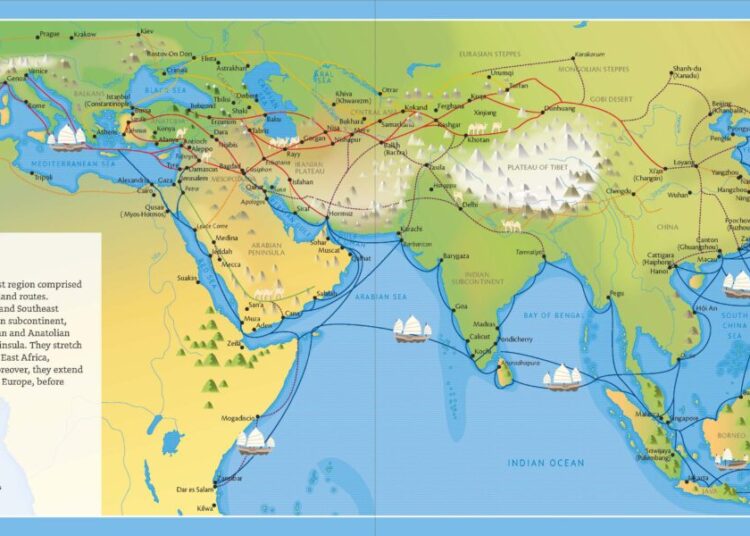Throughout history, trade routes have played a vital role in shaping the world’s economic and cultural landscape. Today, numerous routes exist throughout the world, keeping societies running. But how did this all start?
It began with one trade network during the Han Dynasty in China and lasted for 1,500 years. The Silk Road was a network of trade routes beginning in 138 B.C., according to National Geographic, and connected Europe and East Asia. Its name comes from 1877 A.D. from a German geographer, Ferdinand von Richtofen, who called it that as a metaphor for the collaboration between cultures on this route.
The route itself was 4,000 miles long and saw the exchange of an abundance of goods such as, of course silk, various types of jewels and stones, porcelain, spices, and countless other materials.
The beginning
According to UNESCO, it is believed that the Silk Road was started through the 138 B.C. expedition of Zhang Qian, who, commissioned by Han Emperor Wu Di, demonstrated that it was possible to safely travel to the West from Han China. Since China had coveted silk to trade, numerous civilizations joined the trade route, including the Romans. Because of this exchange, new inventions, religions and culture spread throughout these civilizations, melding them and molding the future.
National Geographic notes that the horses were introduced to China because of the Silk Road, which later led to the Mongol Empire’s strength in the 13th and 14th centuries. Gunpowder traveled from China to Europe, changing warfare for the region completely.
However, one extremely influential element shared on the route was less desirable: disease. Researchers believe that the Black Death of the 1300s spread through the Silk Road, leading to the deaths of 20 million people in Europe.
The route was such an integral part of civilization for so long that many important stories and characters from history experienced the hard life on the route of the Silk Road.
A map of the route shows how the Silk Road connected so many civilizations. (Photo: UNESCO)
Famous explorer Marco Polo traveled the route and wrote about it in his book of travels, “Livres des Merveilles du Monde,” or known in English today as “The Travels of Marco Polo.” According to UNESCO, Polo took a 24-year journey to China, where he often traveled on the famous route.
Lesser-known explorer Ibn Battutah is another important figure of the Silk Road. He too traveled the route and wrote about it. In 1325, 21-year old Battutah set out on a pilgrimage from his home in Tangier, Morocco, to Mecca to fulfill his religious duty and expand his education, according to Britannica. His journeys lasted 29 years and took him through what would be 40 countries today and 75,000 miles.
Because of writings like this, we know that traveling on the Silk Road was not an easy feat.
The route takes travelers through rough terrain like the Gobi Desert and the Pamir Mountains with no upkeep or formal roads throughout its 1,150-year lifespan. Thieves were also common along the passage, looking for lucrative spoils. It was common for large caravans to form with pack animals and camels along for the ride for protection.
Part of the trade route was maritime passages, where just like the thieves on land, pirates were a danger to keep an eye out for. Many ports began to spring up along the coasts, which allowed sailing merchants to freshen their supplies along the way in addition to trading.
Inns appeared over time along the route to capitalize on the numerous merchants traveling.
These inns were known as “caravanserais” and eventually formed a network from China to the Indian subcontinent, Iranian Plateau, the Caucasus and Turkey, and went north to North Africa, Russia and Eastern Europe, according to UNESCO. Some of these structures still exist.
The glory days of the Silk Road came to an end thanks to political tension and land disputes during the Crusades as well as the expulsion of the Mongol dynasty in 1368. In 1453, the last Christian stronghold was defeated in the Near East, and Europeans were no longer able to travel along the western region of the Silk Road, according to UNESCO.
Today, the World Tourism Organization of the U.N. works to revive the history of the route. The organization began a tourism project in 1993, and today there are 33 Silk Road Member States throughout Europe, Africa, Asia and the Pacific. Members work to identify destinations that were integral to the route, including inns, ancient cities, historic buildings, important passageways and more.
The post What was the 1st trade route? appeared first on FreightWaves.














